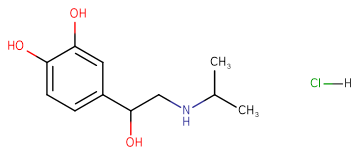
Isoprenaline hydrochloride
CAS No. 51-30-9
Isoprenaline hydrochloride( Isoprenaline | NSC 37745 | NSC 89747 )
Catalog No. M14774 CAS No. 51-30-9
Isoprenaline Hydrochloride is a non-selective beta-adrenergic agonist and structurally similar to adrenaline.
Purity : >98% (HPLC)
 COA
COA
 Datasheet
Datasheet
 HNMR
HNMR
 HPLC
HPLC
 MSDS
MSDS
 Handing Instructions
Handing Instructions
| Size | Price / USD | Stock | Quantity |
| 1G | 30 | In Stock |


|
Biological Information
-
Product NameIsoprenaline hydrochloride
-
NoteResearch use only, not for human use.
-
Brief DescriptionIsoprenaline Hydrochloride is a non-selective beta-adrenergic agonist and structurally similar to adrenaline.
-
DescriptionIsoprenaline Hydrochloride is a non-selective beta-adrenergic agonist and structurally similar to adrenaline.(In Vitro):Isoprenaline (Isoproterenol) hydrochloride (300 nM, 3 min) increases particulate cGMP- and cilostamide-inhibited, low-Km cAMP phosphodiesterase (cAMP-PDE) activity by about 100% in intact rat fat cells.Isoprenaline inhibits insulin-stimulated glucose transport activity in rat adipocytes. Isoprenaline, in the absence of adenosine, promotes a time-dependent (t1/2 approximately 2 min) decrease in the accessibility of insulin-stimulated cell surface GLUT4 of > 50%, which directly correlated with the observed inhibition of transport activity.Isoprenaline (5 nM and 10 μM) increases cyclic AMP levels and this effect is potentiated by cilostamide (10 mM), by rolipram, a cyclic AMP-specific PDE (PDE 4) inhibitor (10 mM) and by cyclic GMP-elevating agents (50 nM ANF or 30 nM SNP plus 100 nM DMPPO).Isoprenaline increases the transcriptional activity of Gi alpha-2 gene to 140% of the control value, whereas gene specific hybridization for Gs alpha remains unchanged.Isoprenaline (20 nM) increases the amplitude of total iK and causes a negative shift of approximately 10 mV in the activation curve for iK, both in the absence and in the presence of 300 nM nisoldipine to block the L-type Ca2+ current.Isoprenaline (20 nM) increases the spontaneous pacemaker rate of sino-atrial node pacemaker cells by 16% in rabbit isolated pacemaker cells.(In Vivo):Isoprenaline (Isoproterenol) hydrochloride (oral, 0.27-0. 64 μg/kg) is extensively metabolizes by a relatively small number of reactions in dogs.
-
In VitroIsoprenaline (Isoproterenol) hydrochloride (300 nM, 3 min) increases particulate cGMP- and cilostamide-inhibited, low-Km cAMP phosphodiesterase (cAMP-PDE) activity by about 100% in intact rat fat cells. Isoprenaline inhibits insulin-stimulated glucose transport activity in rat adipocytes. Isoprenaline, in the absence of adenosine, promotes a time-dependent (t1/2 approximately 2 min) decrease in the accessibility of insulin-stimulated cell surface GLUT4 of > 50%, which directly correlated with the observed inhibition of transport activity.Isoprenaline (5 nM and 10 μM) increases cyclic AMP levels and this effect is potentiated by cilostamide (10 mM), by rolipram, a cyclic AMP-specific PDE (PDE 4) inhibitor (10 mM) and by cyclic GMP-elevating agents (50 nM ANF or 30 nM SNP plus 100 nM DMPPO).Isoprenaline increases the transcriptional activity of Gi alpha-2 gene to 140% of the control value, whereas gene specific hybridization for Gs alpha remains unchanged. Isoprenaline (20 nM) increases the amplitude of total iK and causes a negative shift of approximately 10 mV in the activation curve for iK, both in the absence and in the presence of 300 nM nisoldipine to block the L-type Ca2+ current. Isoprenaline (20 nM) increases the spontaneous pacemaker rate of sino-atrial node pacemaker cells by 16% in rabbit isolated pacemaker cells.
-
In VivoIsoprenaline (Isoproterenol) hydrochloride (oral, 0.27-0. 64 μg/kg) is extensively metabolizes by a relatively small number of reactions in dogs. Animal Model:Dogs Dosage:0.27-0. 64 μg/kg Administration:oral Result:Excreted largely unchanged in urine, only one-third of the radioactivity in urine was in the form of the O-methyl metabolite.Showed plasma radioactivity was almost entirely as conjugated isoprenaline and this metabolite accounted for more than 80% of radioactivity in urine.Showed heart rate returned to base-line values when high plasma concentrations.
-
SynonymsIsoprenaline | NSC 37745 | NSC 89747
-
PathwayEndocrinology/Hormones
-
TargetAdrenergic Receptor
-
RecptorAdrenergic Receptor| CAMP PDE| PI3K
-
Research AreaCardiovascular Disease
-
Indication——
Chemical Information
-
CAS Number51-30-9
-
Formula Weight247.72
-
Molecular FormulaC11H18ClNO3
-
Purity>98% (HPLC)
-
SolubilityWater: 50 mg/mL (201.84 mM); DMSO: 50 mg/mL (201.84 mM)
-
SMILESOC(CNC(C)C)C1=CC=C(O)C(O)=C1.[H]Cl
-
Chemical NameBenzenemethanol, 3,4-dihydroxy-alpha-(((1-methylethyl)amino)methyl)-, hydrochloride, (+/-)-
Shipping & Storage Information
-
Storage(-20℃)
-
ShippingWith Ice Pack
-
Stability≥ 2 years
Reference
1.Degerman E, et al. Proc Natl Acad Sci U S A, 1990, 87(2), 533-537.
molnova catalog



related products
-
Xylazine hydrochlori...
Xylazine Hydrochloride is α2 class of adrenergic receptor agonist.
-
Phenoxybenzamine hyd...
Phenoxybenzamine HCl is a non-specific, irreversible alpha antagonist with long duration of action.
-
Sotalol hydrochlorid...
Sotalol Hydrochloride is an adrenergic beta-antagonist that is used in the treatment of life-threatening arrhythmias.



 Cart
Cart
 sales@molnova.com
sales@molnova.com


